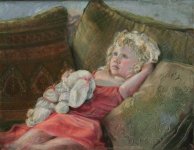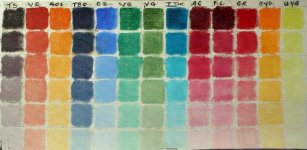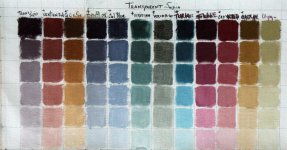Poor Liam, he probably just wants to have fun, and here I am asking for first year college student work work work:-O
Liam you can run the table over several pages, but I suggest you try the "more organized" approach. These will be for more than exercise, they are a resource as you learn to paint, for colors that work and where to get them.
They also do the following:
Give you more info on color than a 100 paintings can
Give you lots of practice in mixing without having any other focus, this also gets you over lots of hurdles in a short time
Give you future reference for what colors you like, that work, so you don't waste money on buying colors easily mixed.
For instance here is my chart for Transparent Sepia, a color not found at the store in the usual brands. It's made by a very premium paint maker in NY. Should I add this to my palette or just add black to umber?
This is how you make a color chart for one color.
On the beginning side of my lined off canvas piece, is Trans Sepia by itself pure and in 5 values dark to light. the next rows are the TS mixed with each of my other colors. To do this you need to make sure your target color, in this case, TS dominates the mixture, so some you have to add more than 50% to the mix, like the Trans. Turquoise which is a modern color ( as opposed to the traditional pigments like sienna) and is very strong. At the top is the mix of the two tube colors mixed pure out of the tube and again the descending col. of 5 values of that mix.
What I can see here is the Golden Orange Sienna and the Cad yellow deep make the same colors, Cad is more useful, so I'll drop the GOS and won't buy another tube, saving money on that for the rest of my life, I'll use it for special items till it's gone.
For two years now I've bought colors as I can afford them in just " I think I want to try that" mode, this is not the way to go for a lot of reasons, but I just started back in oils after 30 years and I wanted to see what's out there.
I can't do really good work until I really know my colors, and getting a set palette sets me free to work without having to be wondering "how can I get that tone," after enough time with the main palette I can just mix it nearly without thinking.
For a beginner I suggest a more limited palette, like 2 reds, 2 yellow, 2 blues, in each group a warm and cool tone. Then white and bt umber and Bt. Sienna. That's 9 colors, to slightly expand and useful for wildlife, add yellow ocher and raw umber. Black is useful later, but deadly on a beginner palette, so suggest you leave that off, mix one with your cool blue and the bt. umber.
A more limited group but still useful would be Bt. Umber, Bt Sienna, Ultramarine Blue, Pthalo Blue, Cad yellow Med, Lemon Yellow or Azo, Perm Red, or Napthol red, and white. All the greens can be mixed from blues, yellows and Bt Sienna. All the oranges from the red and yellows and Bt. Sienna, all the violets from the blues and red.( note for acrylic painters a good violet is very hard to get from red and blues, so I suggest later a violet in the tube, in oils the mix will work splendidly) So that's 7 colors and white.
Remember you are doing this to save time and money, and get lots of experience with color fast, in a way you can reference later.
BTW I am adding Trans Sepia to my palette, it makes gorgeous mixes far superior to BT Umber and black, BU will be gone and replaced by TS







